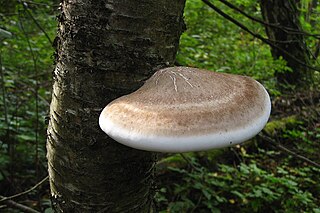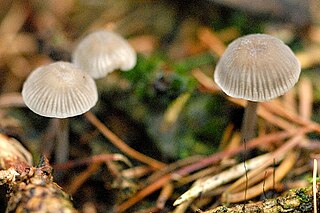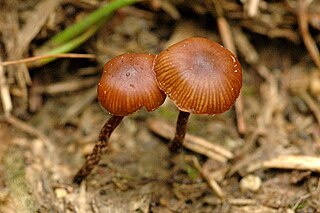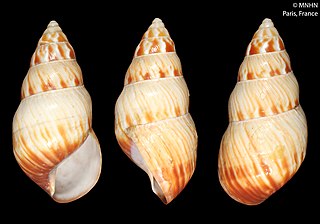In the scientific name of organisms, basionym or basyonym means the original name on which a new name is based; the author citation of the new name should include the authors of the basionym in parentheses. The term original combination or protonym is used in the same way in zoology. Bacteriology uses a similar term, basonym, spelled without an i.

Enoki, also known as velvet shank, is a species of edible mushroom in the family Physalacriaceae. It is well-known for its role in Japanese cuisine, where it is also known as enokitake.

Piptoporus is a genus of bracket fungi in the Fomitopsidaceae family.

Tylopilus is a genus of over 100 species of mycorrhizal bolete fungi separated from Boletus. Its best known member is the bitter bolete, the only species found in Europe. More species are found in North America, such as the edible species T. alboater. Australia is another continent where many species are found. All members of the genus form mycorrhizal relationships with trees. Members of the genus are distinguished by their pinkish pore surfaces.
Scutula is a genus of lichenicolous fungi in the family Ramalinaceae.

Gymnopilus is a genus of gilled mushrooms within the fungal family Strophariaceae containing about 200 rusty-orange spored mushroom species formerly divided among Pholiota and the defunct genus Flammula. The fruit body is typically reddish brown to rusty orange to yellow, medium to large, often with a well-developed veil. Most members of Gymnopilus grow on wood but at times may appear terrestrial if the wood is buried or decomposed. Members of Pholiota and Cortinarius are easy to confuse with Gymnopilus. Pholiota can be distinguished by its viscid cap and duller spores, and Cortinarius grows on the ground. Beginners can confuse Gymnopilus with Galerina, which contains deadly poisonous species.

Partitiviridae is a family of double-stranded RNA viruses. Fungi and plants serve as natural hosts. The name comes from the Latin partitius, which means divided, and refers to the segmented genome of partitiviruses. There are 60 species in the family which are divided into five genera or unassigned to a genus.

Phanerochaete is a genus of crust fungi in the family Phanerochaetaceae.

The Meruliaceae are a family of fungi in the order Polyporales. According to a 2008 estimate, the family contains 47 genera and 420 species. As of April 2018, Index Fungorum accepts 645 species in the family.

The Physalacriaceae are a family of fungi in the order Agaricales. Species in the family have a widespread distribution, ranging from the Arctic, (Rhizomarasmius), to the tropics, e.g. Gloiocephala, and from marine sites (Mycaureola) and fresh waters (Gloiocephala) to semiarid forests (Xerula).

Climacodon is a widespread genus of tooth fungi in the family Phanerochaetaceae.

Collybia is a genus of mushrooms in the family Tricholomataceae. The genus has a widespread but rare distribution in northern temperate areas, and contains three species that grow on the decomposing remains of other mushrooms.
Ascophanus is a genus of fungi in the Ascobolaceae family. The genus has a widespread distribution, and contains 20 species, most of which grow on dung.

Mycena cinerella, commonly known as the mealy bonnet, is an inedible species of mushroom in the family Mycenaceae. It is found in Europe and the United States, where it grows in groups on fallen leaves and needles under pine and Douglas fir. The small grayish mushrooms have caps that are up to 1.5 cm (0.6 in) wide atop stipes that are 5 cm (2.0 in) long and 2.5 mm (0.10 in) thick. Its gills are grayish-white and adnate, with a "tooth" that runs slightly down the stipe. The fungus has both two- and four-spored basidia. As its common name suggests, it smells mealy.

Hapalopilus is a genus of poroid fungi in the family Polyporaceae. The genus is widely distributed. The generic name combines the Ancient Greek words ἁπαλός ("tender") and πιλος ("cap"). Hapalopilus was circumscribed by Finnish mycologist Petter Adolf Karsten in 1881.

Amaurodon is a genus of fungi in the family Thelephoraceae. Species in the genus have resupinate and corticioid fruit bodies that grow on rotting wood. The hymenophore may have pores, teeth, or be smooth, and is typically blue to green in color.

Coniophora is a genus of fungi within the Coniophoraceae family. There are 20 species in the genus, which has a widespread distribution. One notable member is the cellar fungus (C. puteana), which causes wet rot in wood. Molecular analysis has revealed that there are cryptic species in the fungal lineages Coniophora olivacea, C. arida, and C. puteana.

Podostroma is a genus of fungi in the family Hypocreaceae. It was circumscribed by the Finnish mycologist Petter Karsten in 1892. The genus contains 11 species that collectively have a widespread distribution.

Deconica is a genus of mushroom-forming fungi in the family Strophariaceae. It was formerly considered synonymous with Psilocybe until molecular studies showed that genus to be polyphyletic, made of two major clades: one containing bluing, hallucinogenic species, the other non-bluing and non-hallucinogenic species. Deconica contains species formerly classified in the sections Deconica and Coprophila of Psilocybe.

Flammulina is a genus of very small air-breathing land snails, terrestrial pulmonate gastropod mollusks in the subfamily Flammulininae of the family Charopidae.

















